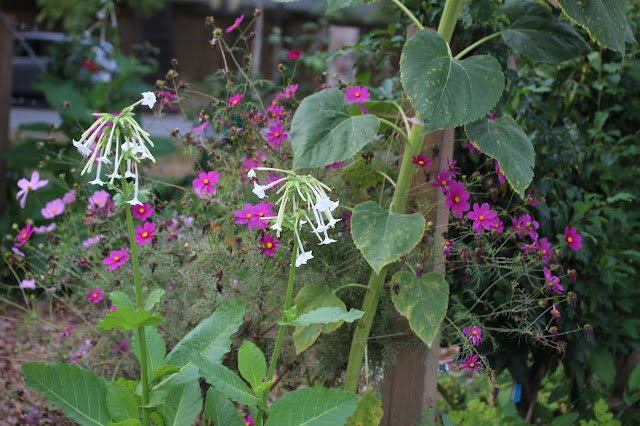Potentilla is a drought tolerant shrub in the rose family. It blooms all summer and into fall and is an essential pollinator plant gap-filler in the garden. The hoverflies and bees love its shallow blossoms. Look for bees collecting chocolate coloured pollen.
Verbena bonariensis is another long-blooming pollinator plant that is essential in our garden. Hummingbirds, butterflies and bees will sip from the nectar rich flowers.
It's too bad Joe pye is called a "weed"! It's another essential pollinator plant that can bloom well into fall. Give the stems a stubble cut in the fall and bees will nest in them next spring and summer. But also, leave some intact so birds can enjoy the seeds.
This is bush honeysuckle (Diervilla rivularis 'Honeybee’) which this yellow-faced bumble bee is enjoying immensely!
Hummingbirds are crazy about the red tubular flowers of cape fuschia and California fuscha (Epilobium canum).
Pineapple sage, another hummingbird magnet, bloomed really late this year. This photo was taken on October 17th. Some additional late-bloomers that the garden would benefit from are the late-blooming perennial sages such as 'hotlips' and the black and blue sages. Let's pack them in there!
The long white tubular flowers of nicotiana are pollinated by moths. Their fragrance persists into the dusk to attract nocturnal visitors.
On warm fall days honey bees will visit the small florets of persicaria.
As the garden winds down there are vegetable flowers here and there such as arugula, squash and tomatillo which will no longer develop fruit, but still shelter and feed bees. Leave these as late as you can--until the first front to support our sweet pollinators.
And speaking of vegetable flowers, bumble bees and humming birds love the flowers of the scarlet runner beans that are climbing up the vertical garden on the east side of the shed. The beans are delicious too--eaten fresh when they are small or left to dry and form those beautiful purple seeds!























































